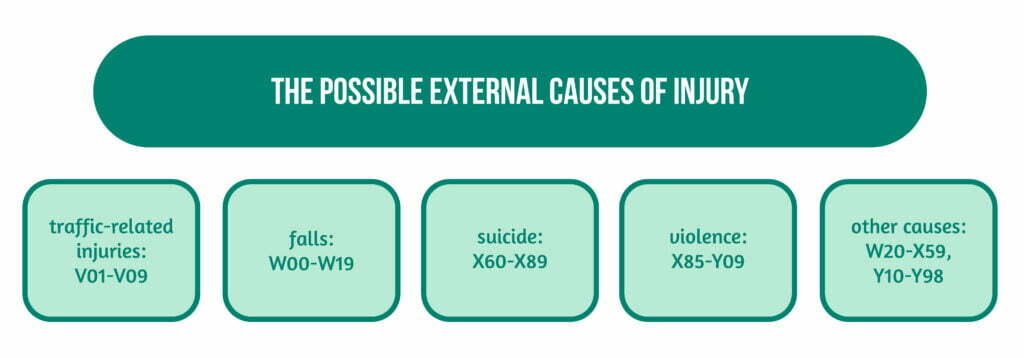Keywords: TBI, epidemiology
TBI in Europe – introduction
Traumatic brain injury (TBI) constitutes a major medical, socioeconomic, and systematic problem around the world. In the United States, there are approximately 235,000 hospitalizations each year for brain injuries, with almost half of the patients developing long-term disability after being treated and discharged from the emergency department [1].
In Europe, TBI represents a major cause of injury-associated deaths and hospital admissions and discharges [2]. More details are presented on our article Treatment of traumatic brain injuries (TBI) across Europe – findings from CENTER-TBI.
TBI represents an important cause of morbidity and mortality in young persons. Recent studies show that TBI incidence increases, especially in high-income countries, in people above 65 years old. Due to long-term disabilities, traumatic brain injuries have a major impact on the lives of survivors and their families. Patients with brain injuries experience decreased life expectancy and increased mortality rates compared to the general population. Moreover, TBIs represent a burden for the healthcare system due to the direct and indirect (loss of productivity) costs [2].
TBI Studies in Europe
In Europe, only a few studies were published on TBI epidemiology to explore and use the data to improve the healthcare system. Nonetheless, the research presented important limitations as the studies were not population-based, were based on data recovered from selected hospitals, and used a single- or multicenter design.
Studies showed that the estimated incidences are higher in population-wide analysis than in hospital-based or registry-based analysis. Still, one must keep in mind that even population-based studies have limitations. It is thought that research based on routinely collected data, such as mortality registries or hospital discharge databases, could provide an insight into population-based patterns. This type of studies generally have country-wide coverage, and consider all the TBIs admitted to hospital or the ones that were fatal. The disadvantage of this type of research is that scientists do not have access to individual patient data and rely on definitions provided by statistical services [2].
Study on the epidemiology of traumatic brain injuries in Europe
Amplitude of the study
The current study analyzed data from patients discharged from 24 European countries and deaths from 25 European countries in 2012. All data was centrally aggregated following specific guidelines. The research estimates the age-adjusted mortality rates and age-adjusted hospital discharge rates for each participant country by sex and provides pooled age-adjusted estimates. What makes this study unique and a valid European epidemiological analysis of hospital-based TBI incidence and mortality is the use of a unified approach to calculating rates and the possibility of performing age adjustment on the raw data. Another positive argument is the high number of participant countries. It is considered that this study could serve as a basis for more analyses of the overall population burden of TBI in Europe because it takes into consideration the level of disabilities and the potential years of lost life. Also, it could be used in the future for updated analyses on a European scale [2].
How was the research conducted?
The research was created using a cross-sectional methodology across all participant European countries. The inclusion of countries in the analysis was based on data availability. All the data used for analyses were obtained and aggregated by Eurostat. The collected information was combined using sex and diagnostic into 5 years age groups.
Several variables and outcomes were defined. Hospital discharge was explained as the formal release of the patient from the hospital, regardless of the status (alive, dead, or transferred to another hospital). The research did not include patients transferred within the same institution and the brain injuries that did not need admission to a hospital. The patients were grouped as follows:
- inpatient- at least 1 night stay
- day cases – discharged on the same day
The International Shortlist for Hospital Morbidity Tabulation (ISHMT) was used to code the hospital discharge diagnoses. The following codes were used as inclusion criteria:
- 1901 – intracranial injuries/ICD-10 code S06
- 1902 – other injuries to the head/ICD-10 codes S00-S05 and S07-S09
For this study, the cause of death was defined as:
- the underlying cause was the disease or injury that started the train of morbid events that led directly to death
- the accident that produced the fatal injury
For mortality information death certificates were used. The ICD-10 classification was used in this study in order to code the cause of death (codes S00-S09 and T90). The possible external causes of injury are presented, by categories, in the Figure below:

Results
Results from the statistical analysis were presented as age-adjusted hospital discharge rates and mortality rates per 100,000 people stratified by:
- country
- sex
- external cause (in case of death)
For extrapolating the results to the 28 participant states and the whole of Europe, crude rates were calculated using annual mid-year populations obtained from the Eurostat. After that, the rates were age-adjusted using the direct method with the standard European population, based on EFTA (European Free Trade Association countries). In order to evaluate their importance as a cause of injury-related death, the researchers calculated, out of overall injury-related mortality rates, the proportions of TBI-related mortality rates. By doing so, unspecific codes and deaths caused by frost, heat, intoxications, and cases with other causes were excluded from injury-related deaths. In order to estimate age-adjusted hospital discharge rates and mortality rates, pooled analysis was used. DerSimonian’s random effect model and Laird method were used to model possible heterogeneity of rates in different countries [2].
The European Commission funded the study and collected the primary data with the assistance of Eurostat. Still, the funder did not have any role in interpreting data, writing the manuscript, or deciding to submit it for publication. Instead, the corresponding author was responsible for the decision to submit for publication, and he had integral access to the data in the study.
Of all the TBI-related hospital discharges identified (1,375,974), the majority were men (61%) between 0-and 44 years old. Only a small percentage (29%) were older than 65 years, but in this category the percentage of female patients was higher than that of male patients. Important differences in the hospital discharge rates were observed across Europe, with the highest being in Austria and the lowest in Portugal. In addition, in male patients compared to female patients, the hospital discharge rates were higher in all countries that participated in the study. Of the deaths identified in the participant countries (33415), the majority were represented by male individuals. The group with most deaths was 65 years old or higher, with female patients suffering the most deaths in this category. Results show that mortality was lower in Turkey and higher in Switzerland. Mortality related to TBI was higher in men, while brain injuries resulting from traffic accidents and falls were most prevalent.
Were the results similar in different countries?
Homogeneity and between-country comparability were ensured by Eurostat from its data collection and aggregation and allowed for age adjustment. Despite similar data acquisition and analysis approaches, the focus was mainly on between-country differences. Pooled crude hospital discharge rates and pooled crude mortality rates were extrapolated to the European Union and Europe population as defined by the UN in 2012 to estimate the impact of TBI in the territory. Thus, in 2012, 1,445,526 TBI-related hospital discharges and 56,946 TBI-related deaths were reported in the European Union. In comparison, there were 2,095,353 TBI-related hospital discharges across Europe and 82,546 TBI-related deaths in the same year. For easier global comparisons, the researchers age-adjusted their results using the WHO World population and the age-adjusting using the European standard. The data showed that 19% of all patients in the Eurostat database were treated as day-cases, with most cases in the UK and fewest in Hungary. No difference between sexes was observed in the proportions of day-cases. Besides the UK, Poland was another country that ranked above all other European countries in day-case hospital discharge rates. Compared to day cases, the number of inpatient cases coded as intracranial injuries was almost double. The average number of days in the hospital for inpatients with intracranial injuries was 7.9 days, and 3.7 days for other head injuries.
What did the statistical analysis revealed?
After the analysis, researchers found in the participant countries; a 300 per 100,000 people pooled age-adjusted discharge rate due to brain injury and a 12 per 100,000 people pooled age-adjusted mortality rate due to the exact cause as before. TBI was the major cause of mortality in 37% of cases, with the majority being represented by male patients. Substantial differences between countries were found in reported hospital discharge and mortality rates. The study approximated that in the year 2012, there were 1,5 million TBI-related hospital discharges and 57,000 TBI-related deaths in the European Union. In addition, in Europe, they approximated 2,1 million TBI-related hospital discharges and 82,000 deaths. The differences in coding the diagnoses and collecting procedures might be the reason for the between-country differences found. Some factors, such as differences in dealing with newborn patients, dealing with transfers within the same hospital, or dealing with non-residents, were thought to be the reason for selection bias and extreme outliner. The pooled age-adjusted hospital discharge rate was recalculated after excluding the extremes (Portugal and Austria), and it was lower than the one calculated before. Per-capita GDP was thought to influence the differences found between countries because countries with high GDP had low pooled rates. Geographical location was another factor that influenced the variations found. There was also a six-times difference between the lowest and highest age-adjusted mortality. The data for cause of death could be interpreted as homogeneous compared to the hospital discharge rates because of the European Union regulation.
Bias between-country comparison could be influenced by a number of different factors, presented in the Figure 2 below:

Epidemiological patterns
Some TBI-related deaths might be included in multiple injuries cases, unknown or other causes, leading to some variations. This could explain the low mortality rate in Turkey. Only a low proportion of cases were classified as having TBI as the cause of death, but many deaths were attributed to multiple injuries (49% here compared to 21% elsewhere). Countries with high per-capita GDP also had higher mortality rates than countries with low per-capita GDP.
No significant effect was found when fitting a meta-regression model with these categories. Because there is a high number of TBI survivors in Europe annually, and these patients live with the consequences of the injury could explain the differences between mortality and hospital discharge rates. Other studies, such as Global Burden of Disease, consider the number of years that patients live with a disability due to TBI to capture the entire burden of this disease.
The lack of valid epidemiological data limited TBI research in Europe. However, the present study could create the grounds for such research. Only three systematic reviews were published in Europe on the epidemiological patterns of TBI. The study at hand presents similar results, along with a better methodology which tackles the limitations of the previous systematics reviews.
Limitations of research
Limitations of the systematics reviews:
- study populations
- heterogeneity of the methods
- time range of included studies
The limitations of the current study are presented in the Figure below:

In conclusion, TBI is a significant cause of hospital admissions and deaths in Europe, and further studies are needed to fully understand this disease’s burden on the healthcare system.
References
- Corrigan JD., Selassie, AW & Orman, JAL. The epidemiology of traumatic brain injury. J. Head Trauma Rehabil. 2010; 25, 72–80 DOI: 10.1097/HTR.0b013e3181ccc8b4
- Majdan, M. Plancikova D, Brazinova A, Rusnak M et al. Epidemiology of traumatic brain injuries in Europe: a cross-sectional analysis. Lancet Public Health 2016; 1, e76–e83 DOI: 10.1016/S2468-2667(16)30017-2




